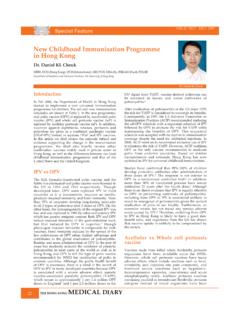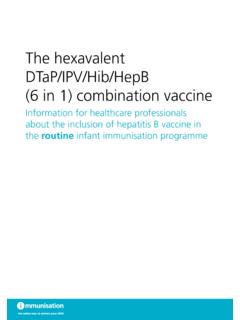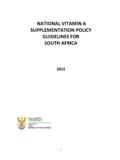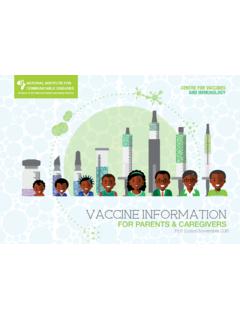Transcription of Immunisation against infectious disease
1 Immunisation against infectious disease Immunisation against infectious disease Edited by Dr David Salisbury CB FRCP FRCPCH FFPHM Director of Immunisation Department of Health Dr Mary Ramsay BSc MB BS MRCP MSc MFPHM FFPHM Consultant Epidemiologist Health Protection Agency and Dr Karen Noakes BSc PhD Principal Scientist Immunisation Department of Health Published by TSO (The Stationery Office) and available from: Online Mail, Telephone, Fax and E-mail TSO PO Box 29, Norwich, NR3 1GN Telephone orders/General enquiries: 0870 600 5522 Fax orders: 0870 600 5533 E-mail: Textphone.
2 0870 240 3701 TSO Shops 123 Kingsway, London,WC2B 6PQ 020 7242 6393 Fax 020 7242 6394 16 Arthur Street, Belfast BT1 4GD 028 9023 8451 Fax 028 9023 5401 71 Lothian Road, Edinburgh EH3 9AZ 0870 606 5566 Fax 0870 606 5588 TSO@Blackwell and other Accredited Agents Crown Copyright 2006 Published by The Stationery Office under licence from the Department of Health Department of Health Wellington House 133 155 Waterloo Road London SE1 8UG First edition 1992 Second edition 1996 Third edition 2006 ISBN-10 0-11-322528-8 ISBN-13 978-0-11-322528-6 Printed in Great Britain by The Stationery Office N5456496 C1950 11/06 Contents page Acknowledgements vi Preface vii Part 1 Principles.
3 Practices and procedures 1 Immunity and how vaccines work 1 2 Consent 7 3 Storage, distribution and disposal of vaccines 17 4 Immunisation procedures 25 5 Immunisation by nurses and other healthcare professionals 35 6 Contraindications and special considerations 41 7 Immunisation of individuals with underlying medical conditions 49 8 Vaccine safety and adverse events following Immunisation 53 9 Surveillance and monitoring for vaccine safety 65 10 Vaccine Damage Payment Scheme 75 11 Immunisation schedule 79 12 Immunisation of healthcare and laboratory staff 83 Part 2 The diseases.
4 Vaccinations and vaccines 13 Anthrax 91 14 Cholera 99 15 Diphtheria 109 16 Haemophilus influenzae type b (Hib) 127 17 Hepatitis A 143 18 Hepatitis B 161 19 Influenza 185 20 Japanese encephalitis 201 21 Measles 209 22 Meningococcal 235 23 Mumps 255 24 Pertussis 277 25 Pneumococcal 295 26 Polio 313 27 Rabies 329 28 Rubella 343 29 Smallpox and vaccinia 365 30 Tetanus 367 31 Tick-borne encephalitis 385 32 Tuberculosis 391 33 Typhoid 409 34 Varicella 421 35 Yellow fever 443 Index 455 Acknowledgements Producing a volume as complex.
5 Comprehensive and wide-ranging as this required a huge team effort from many staff at the Department of Health and the Health Protection Agency in particular. First, we would like to thank all those staff who re-drafted the chapters and the individual specialists who contributed their expertise in technical areas. Second, we must thank the members of the Joint Committee on Vaccination and Immunisation who made constructive comments on the drafts and, third, we must give special thanks to those individuals who drew the drafts together into a meaningful whole.
6 These include Judith Moreton, Joanne Yarwood, Dr Dorian Kennedy, Dr Arlene Reynolds, and Chris Owen. STOP PRESS Just prior to publication, the World Health Organization published a paper entitled Temperature sensitivity of vaccines. See page 23 for more information. NOTE This edition reflects policy current at the time of going to press November 2006 Updates are available at vi Preface The Immunisation programme in the UK continues to evolve, meeting the demand to improve the control of infectious diseases through vaccination.
7 Since the last edition of Immunisation against infectious disease (the Green Book), the Immunisation programme has seen a number of changes, to both the vaccination schedule and to peoples attitudes to vaccination. New vaccines have been introduced against meningococcal group C and pneumococcal infections which are the cause of serious diseases. At the same time, as the epidemiology of some diseases changes, certain vaccination schedules have been altered: the school s BCG programme has stopped and a more targeted approach to BCG vaccination has been adopted.
8 Other changes to the Immunisation schedule, such as the introduction of a Hib/MenC booster at 12 months of age and the reduction of MenC doses given as a primary course, reflect the importance of diligent surveillance and clinical trials to study the most effective way to use vaccines in the UK schedule. The Joint Committee on Vaccination and Immunisation (JCVI) continues to play a pivotal role in advising the UK s Health Departments, providing independent scientific advice for the whole programme .
9 JCVI meets three times a year and comprises experts from many areas of medicine and clinical practice especially related to Immunisation . The members are independent of government, work to the highest international standards as recognised by the World Health Organization and publish their recommendations and advice, together with those of the various sub-committees, on the Department of Health website. The objectives of the national Immunisation programme include providing clear, evidence-based communications that meet the needs of parents and health professionals, and ensuring that those working in primary care are provided with the support required to implement vaccination programmes effectively.
10 Following the ill-founded MMR scare, it has become even more important for those working in the field to be able to communicate to parents the benefits of vaccination, the known side effects of vaccines and the safety and efficacy of vaccines to allay fears. vii I look forward to the exciting work that lies ahead in developing an Immunisation programme that offers safe and effective protection for our children and families both today and in the future. Andrew J Hall Chairman, Joint Committee on Vaccination and Immunisation viii 1 Immunity and how vaccines work Introduction Immunity is the ability of the human body to protect itself from infectious disease .




